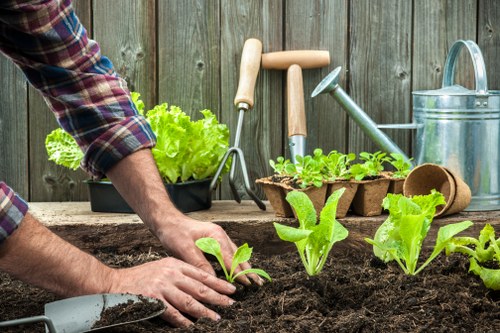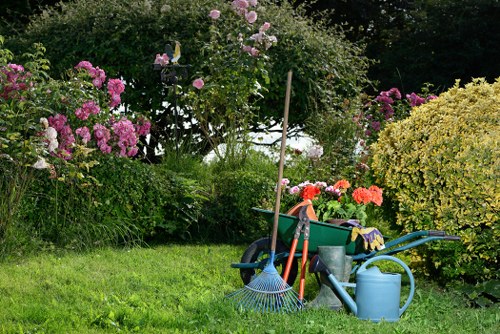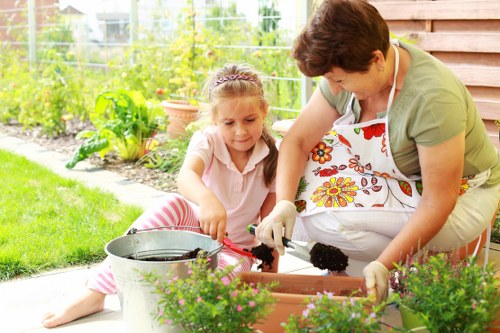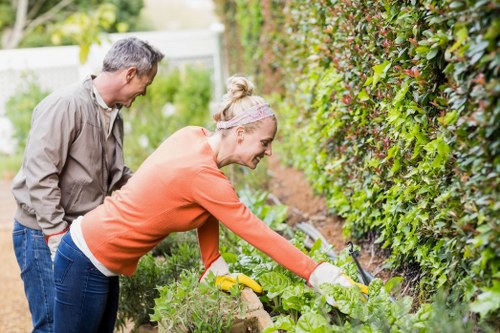Gardeners Canary Wharf: Cultivating Urban Green Spaces

In the heart of London's financial district stands a surprising oasis where nature meets modernity. Gardeners in Canary Wharf have not only transformed city spaces into vibrant green retreats, but have also fostered a cultural movement that embraces urban horticulture with both passion and innovation. This article explores the evolution of gardening in this bustling metropolis, uncovering stories of community, sustainable practices, and a shared commitment to bettering the environment.
Over the past decades, Canary Wharf has evolved from a dense financial hub into a place where green spaces have become as crucial as high-rise buildings. Gardeners in Canary Wharf are working meticulously to integrate nature into urban life by creating small gardens, rooftop havens, and community plots that support local flora. Their work not only provides aesthetic pleasure but also enhances the quality of urban living.
Historically, the transformation of urban spaces in this area was met with skepticism, yet today, the quiet revolution of urban gardening brings hope and renewal. The passion for cultivating green areas has reduced the urban heat island effect, supported biodiversity, and improved air quality. Gardeners see every plant as a symbol of resilience and progress, redefining city life for future generations.
The Evolution of Urban Gardening in Canary Wharf

Urban gardening in Canary Wharf has a deep-rooted history that intertwines with the district's larger narrative of renewal and innovation. From small balcony gardens to dedicated community spaces, each project has contributed to a legacy of environmental stewardship. As the area evolved, so did the methods and passion of those who believed that even the smallest patch of soil can bring a slice of paradise to urban dwellers.
Once known solely for its imposing skyscrapers and bustling financial markets, Canary Wharf now proudly hosts a series of green projects spearheaded by dedicated gardeners. These initiatives focus on sustainable living, environmental education, and the creation of communal gardens that inspire residents and workers alike. The transition from barren concrete to lush greenery is a testament to the transformative power of community-led gardening projects.
Garden Initiatives in the Modern Era
In recent years, modern garden initiatives have combined technology with tradition. Innovative techniques such as vertical gardening, hydroponics, and reclaimed water systems have redefined how gardeners approach urban spaces. The result is a series of highly efficient, environmentally friendly gardens that serve both practical and aesthetic purposes.Techniques and Trends in Urban Horticulture

As urban spaces continue to shrink, resourceful gardeners in Canary Wharf are adopting creative techniques to maximize greenery. One popular trend is the use of vertical gardens, which transform bare walls into cascading arrays of foliage and color. These installations are not just visually appealing but also play an important role in reducing carbon footprints and managing urban temperatures.
Another significant trend is the rise of container gardening. By utilizing pots, recycled materials, and modular systems, urban horticulturists can create temporary or shifting green spaces that adapt to the dynamic urban landscape. This flexible approach allows residents and businesses to experiment with greenery without committing to permanent alterations, making it ideal for rented or transitional properties.
Moreover,
community-focused urban horticulture
has become a cornerstone of gardening in Canary Wharf. Workshops, public planting days, and collaborative projects have united diverse groups of people, from local residents to business professionals, all working together to foster sustainable environments. This movement reflects a key aspect of modern urban life: the belief that even in a space dominated by commerce and industry, nature can thrive if given the chance.Community and Environmental Impact

The influence of gardening in Canary Wharf extends beyond creating visually appealing spaces—it has a profound social and environmental impact. Community gardens serve as gathering points, where people can share skills, stories, and ideas, fostering a sense of belonging and collective responsibility. Whether it’s through regular workshops or spontaneous meetups, gardens have redefined community interaction in a bustling urban space.
Educators and environmental advocates in the area champion the idea that gardening teaches valuable lessons about sustainability. By nurturing plants, individuals learn about conservation, resource management, and the intricate balance of nature. These green spaces stand as living laboratories where experiments in sustainable living are conducted daily.
Environmental Benefits at a Glance
It is important to note the tangible environmental benefits of urban gardening. From improved air quality and noise reduction to enhanced mental health for residents, the presence of green spaces contributes significantly to the overall well-being of the city. With initiatives focusing on organic practices and eco-friendly methods, the efforts of gardeners are paving the way for an urban environment that respects nature and promotes sustainability.Gardening in Canary Wharf: Hidden Gems and Local Spots

Amidst the hum of city life, there are numerous hidden gems in Canary Wharf where gardening has taken center stage. From rooftop sanctuaries brimming with seasonal blooms to tucked-away courtyards that serve as personal retreats, these spots offer a refreshing counterbalance to the urban pace. Many of these enclaves are the result of long-term projects by passionate gardeners who have braved the challenges of urban land management to create havens of tranquility.
Local organizations and neighborhood groups have played a pivotal role in scouting and preserving these green corners. With a shared vision for a greener Canary Wharf, many community-led efforts have taken root in unexpected places, demonstrating that even the most modern urban areas can harbor pockets of natural beauty. These projects serve as an inspiration to both seasoned horticulturists and aspiring green thumbs alike.
Another fascinating aspect is how private and corporate entities have begun to integrate gardens into their urban designs. In some cases, office towers proudly showcase rooftop gardens that provide a daily retreat for busy professionals. These spaces are not only visually inviting but also serve as a reminder that growth and nature can coexist harmoniously with modern architecture.
Exploring Nearby Areas

Canary Wharf is ideally situated amidst a variety of unique neighborhoods and districts that offer further opportunities for nature enthusiasts. Each area provides its own distinct charm and potential for gardening projects, making the entire region a thriving hub of green innovation. In this section, we explore 12 nearby areas where gardening and local community initiatives have flourished.
- Isle of Dogs: Located just to the west, this residential area is known for its riverfront views and expansive open spaces, making it ideal for community gardens.
- Limehouse: A historic area with maritime roots, Limehouse features narrow streets and small patches of green, ideal for urban gardens that tell a tale of tradition meeting modernity.
- Poplar: With its vibrant street life and numerous local markets, Poplar supports community-driven gardening projects that aim to beautify underutilized spaces.
- Wapping: Noted for its cobblestone alleys and waterfront charm, Wapping offers hidden garden spots that have become sanctuaries for local flora.
- Shadwell: A melting pot of cultures, this area blends historic architecture with emerging urban greening efforts, forming a unique landscape for horticultural experiments.
- Whitechapel: While known for its rich cultural history, Whitechapel also hosts several community gardens that focus on both aesthetic improvement and community outreach.
- Tower Hamlets: The broader district encompassing Canary Wharf, Tower Hamlets offers multiple opportunities for green projects that contribute to environmental sustainability.
- Stratford: A few miles to the northeast, Stratford is a bustling hub that balances urban development with nature, boasting several modern garden installations.
- Blackwall: With its mix of modern high-rises and older structures, Blackwall presents projects that blend historical renovation with new green spaces.
- Millwall: Known for its close-knit community, Millwall has seen a surge in pop-up gardens and creative green initiatives over recent years.
- Rotherhithe: Positioned along the Thames, this district is celebrated for its scenic views and community-driven gardening projects that enhance local pride.
- Greenwich: Though slightly further afield, Greenwich contributes cultural vibrancy and numerous public gardens that serve as an inspiration for urban greening elsewhere.
These areas, each with its distinct character, play a crucial role in the overall narrative of urban gardening in and around Canary Wharf. Their collaborative efforts and shared knowledge encourage a regional approach to sustainability, ensuring that each community benefits from, and contributes to, the green movement.
The Future of Sustainable Gardening in Urban Landscapes

Looking ahead, the trends in urban gardening suggest a future wherein cities are increasingly interwoven with nature. Innovations like smart irrigation systems, renewable energy-powered greenhouses, and biodiverse plant selections are becoming integral parts of the urban gardening toolkit. Gardeners in Canary Wharf are at the forefront, setting examples about how small changes in planting strategies can lead to large-scale environmental benefits.
There’s a growing realization that urban spaces can and should serve multiple functions—economic, social, and ecological. With environmental challenges becoming more pronounced, the role of urban gardens in reducing carbon footprints, conserving water, and encouraging recycling practices is more important than ever. Through education and public initiatives, the gardening community is equipping residents with the knowledge and tools to contribute actively to this green transformation.
Local councils and private organizations are increasingly collaborating to create policies that support sustainable urban development. The momentum behind these changes is palpable, fueled by the vision of creating cities that nurture life rather than merely accommodate it. Initiatives focusing on eco-friendly landscaping and regenerative practices are steadily gaining ground, and Canary Wharf is proving to be a dynamic canvas for these ambitious ideas.
Embracing a Greener Lifestyle in the City

Beyond the visible transformation of urban spaces, gardening in Canary Wharf has inspired a broader shift in lifestyle. Locals are now more mindful of their environment; many have taken up gardening as a hobby, finding solace and fulfillment in hands-on care for plants. Simple actions, such as tending a windowsill herb garden or engaging in community planting events, have had a significant impact on mental and physical well-being.
This new way of living emphasizes a balance between work and nature, encouraging residents to slow down and appreciate small moments of beauty. Every plant nurtured is a step toward a more sustainable future, reminding us that even in a busy urban center, nature is always within reach. In essence, gardeners in Canary Wharf are not just cultivating plants—they are cultivating a mindset that values nature, sustainability, and community spirit.
From an economic perspective, integrating green spaces within urban landscapes has also proven beneficial. Employers have noted increased productivity and improved morale among workers who have access to green spaces. This symbiotic relationship between business and nature paves the way for a future where urban planning and environmental sustainability are mutually reinforcing pillars of city life.
Challenges and Opportunities for Urban Gardeners

Despite the many advantages, gardening in an urban environment like Canary Wharf is not without challenges. Limited space, pollution control, and resource management are significant obstacles that require innovative solutions. Gardeners must often balance the demands of a high-density area with the need for sufficient natural resources, pushing them to develop creative strategies in their work.
Nonetheless, these challenges also present unique opportunities. The necessity for economies of scale in resource management has spurred the adoption of cutting-edge technologies and sustainable practices. Urban gardeners in Canary Wharf are now active participants in pilot projects that test new forms of sustainable horticulture. Their efforts pave the way for better methods of water conservation, energy efficiency, and ecological restoration.
Moreover, these challenges have fostered a strong sense of community among local gardeners. Collaborative ventures such as seed exchanges, shared tool libraries, and regular workshops have emerged as effective strategies for overcoming urban gardening obstacles. Such initiatives have not only mitigated the typical issues faced but have also reinforced the bonds within communities, turning every garden into a symbol of mutual support and creative problem-solving.
Integrating Technology with Traditional Horticulture

In the midst of technological advancements, traditional gardening techniques continue to hold immense value. Gardeners in Canary Wharf are uniquely positioned in that they draw on both time-honored horticultural practices and modern innovations. For instance, while organic composting and crop rotation remain essential, they are now being paired with smart sensors that monitor soil moisture and temperature.
This merger of old and new provides a robust framework for urban gardening. The use of apps and digital calendars to plan planting cycles, combined with automated watering systems, makes managing urban gardens more efficient than ever. Gardeners are not only working smarter but are also setting benchmarks for sustainability that can be replicated in other cities worldwide.
Furthermore, the integration of technology in gardening has opened up new avenues for community engagement. Online forums, virtual garden tours, and social media groups have become powerful tools in sharing knowledge and fostering collaboration. By blending the wisdom of the past with the innovations of the future, gardeners in Canary Wharf are creating a hybrid model of urban horticulture that is both traditional in spirit and revolutionary in practice.
Cultivating Resilience through Nature

The ongoing success of gardening initiatives in Canary Wharf is a testament to the resilience of both nature and the human spirit. In an environment traditionally dominated by glass and concrete, each flourishing garden symbolizes hope, persistence, and the power of renewal. Gardeners work against the odds, demonstrating that even in the most challenging urban landscapes, nature can be nurtured with creativity and dedication.
Every seed planted and every sapling nurtured carries with it a promise for the future. Urban gardening is not merely about beautification; it is an act of defiance against the relentless pace of modern life. It is a reminder that amidst the chaos of economic growth and urban development, there is always a place for the quiet, steadfast growth of nature.
As more of these green spaces emerge, they instill a sense of resilience in the community. Residents find comfort and motivation in the simple act of nurturing a plant, fostering a healthier mindset and a community bound by shared goals. The spirit of collaboration and innovation among local gardeners continues to inspire similar movements in other parts of the city.
Final Thoughts: A Green Future for Urban Centers

The journey of Gardeners Canary Wharf is a vivid illustration of how urban environments can be transformed through the love of nature and dedication to sustainable practices. As more gardens bloom among the city’s towering structures, residents and visitors alike are reminded of the importance of nurturing the earth amidst rapid urban development.
This movement encourages all urban dwellers to consider the impact of green spaces on mental, physical, and environmental health. By embracing urban horticulture, cities can evolve into places where development and nature coexist harmoniously, paving the way for a future that is as rich in biodiversity as it is in opportunity.
Looking forward, the collaborative efforts seen in Canary Wharf are likely to spread. The fusion of technology, community spirit, and traditional gardening practices provides a promising blueprint for cities worldwide. In a time when the environment faces unprecedented challenges, these local initiatives offer hope and concrete examples of how a greener future is not only possible but already underway.
FAQs: Common Questions About Gardeners in Canary Wharf
Q1: What makes gardening in Canary Wharf unique?
A1: Gardening in Canary Wharf blends urban innovation with sustainable practices. The area's high-density environment challenges gardeners to use creative space-saving solutions, such as vertical and container gardening, making it a unique urban horticultural hub.
Q2: How do community gardens in Canary Wharf benefit local residents?
A2: Community gardens in Canary Wharf improve air quality, reduce urban heat, and offer spaces for social interaction. They also provide educational opportunities and promote physical and mental well-being.
Q3: Are there any local initiatives supporting urban gardening?
A3: Yes, local councils and community groups regularly organize workshops, seed exchanges, and public planting events to support urban gardening initiatives and foster sustainability in the area.
Q4: What nearby areas also embrace urban gardening practices?
A4: Areas like the Isle of Dogs, Limehouse, Poplar, Wapping, Shadwell, Whitechapel, Tower Hamlets, Stratford, Blackwall, Millwall, Rotherhithe, and Greenwich actively support urban gardening projects.
Q5: How can I get involved in gardening initiatives in Canary Wharf?
A5: You can start by joining local workshops, visiting community gardens, or participating in online forums and events organized by local environmental and gardening groups.